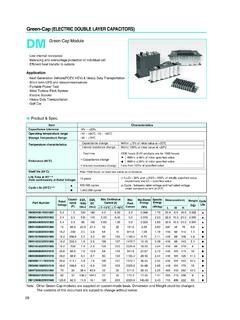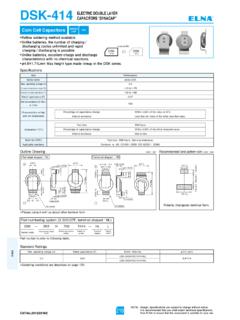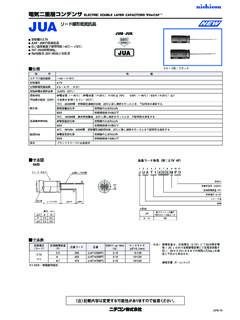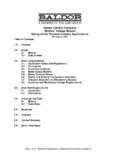Transcription of FAILURE MODES OF TANTALUM CAPACITORS MADE BY …
1 FAILURE MODES OF TANTALUM CAPACITORS MADE BY DIFFERENT. TECHNOLOGIES. P. Vasina, T. Zednicek , J. Sikula*, J. Pavelka*. AVX Czech Republic , Dvorakova 328, 56301 Lanskroun, Czech Republic *. CNRL TU Brno, Technicka 8, 60200 Brno, Czech Republic successive physical processes: thermal ABSTRACT. breakdown brought on by increasing conductance Generally, TANTALUM capacitor FAILURE from Joule heating, avalanche and field emission MODES have been discussed both for the standard break, an electromechanical collapse due to the manganese dioxide cathode and the new attractive forces between electrodes, conductive polymer (CP) type.
2 For standard electrochemical deterioration, dendrite formation TANTALUM in the normal operation mode, an and so on. Dielectric breakdown causes electrical breakdown can be stimulated by an destruction in the insulator and across the increase of the electrical conductance in channel electrodes mainly by melting and evaporation, by an electrical pulse or voltage level. This leads sometimes followed by thermal runaway. To to capacitor destruction followed by thermal obtain more information about the TANTALUM MIS. breakdown. In the reverse mode, we have (metal-insulator semiconductor) heterostructure reported that thermal breakdown is initiated by an and find a correlation between the dielectric increase of the electrical conductance by Joule breakdowns, we investigated operating heating at a relatively low voltage level.
3 Parameters which were current and voltage Consequently, a feedback cycle consisting of dependent, both in the normal mode where the temperature - conductivity - current - Joule heat - TANTALUM electrode is positively biased, and in the temperature, ending with electrical breakdown reverse mode where the TANTALUM electrode is was created. Both of these breakdown MODES negatively biased. possess a stochastic behavior and can be hardly Breakdown destruction is not only due to a localized in advance. Conductive polymer sudden breakdown event, but is also due to CAPACITORS have shown a slightly different current subsequent current flow, which makes it difficult to conductivity mechanism compared to standard interpret the origin and kinetics of the breakdown.
4 TANTALUM CAPACITORS . The breakdown of CP. dielectrics is similar to avalanche and field Special conditions appear when self- emission breaks. It is an electromechanical healing processes are involved. In some cases, the collapse due to the attractive forces between incidence of weak spots and bulk breakdown areas electrodes, electrochemical deterioration, can be reduced. During laboratory experiments, dendrite formation, and so on. However, some thermal breakdown can be measured without self-healing of the cathode film has been destroying the device, and electrical breakdown can reported. This can be attributed to film be observed with minimal damage occurring.
5 An evaporation, carbonizing or reoxidation. Not all additional healing process can also be inferred;. of the breakdowns of CP CAPACITORS can lead to oxygen can be released from the manganese dioxide self-healing or an open circuit state. Short circuits counter-electrode, which then reduces weak spots can also occur. inside the dielectric by allowing local regeneration of TANTALUM dioxide or eliminating charge traps (similar to an electrical anodization and/or INTRODUCTION. passivation process). There are two possible self-healing Our investigation of dielectric methods reported on conductive polymer breakdowns was oriented toward finding a basic materials.
6 The first theory is based on an set of parameters that would describe this evaporation process. Polymers tend to have fairly phenomenon and its relation to the reliability and low melting and evaporation temperatures. If the quality of the final product. Basically, dielectric current into the fault is sufficient to heat the breakdown can be produced by a number of polymer, it can evaporate and eliminate CTI CARTS USA 01. Frenkel and Schottky mechanism. One can connection to that site. The secondary theory of assume that electrons may tunnel from the MnO2. self-healing proposes that the polymer absorbs electron level through the interface barrier inside oxygen as it is heated at the fault site, thereby the Ta2O5 dielectric layer.
7 The electric field in the creating a high resistance cap and sealing the Ta2O5 assists in the release of electrons from the current to the fault site, in the much the same traps, suggesting that electrons are hopping from manner as the MnO2 healing. [1]. one trap to the other with low mobility. The The dielectric breakdown processes are not Schottky effect is frequently considered to be an strictly deterministic ones. Our experimental results interface effect, while the Poole-Frenkel effect is for thin oxide films show that electric breakdown a bulk effect. does not occur at a sharply defined value of the One can say primarily that electrical applied electrical field.
8 The breakdown is a result of breakdowns appear at high electrical field, at stochastic processes, and the final breakdown random sites and time. corresponds in many cases to the sum of independent events. CURRENT TRANSPORT IN REVERSE. MODE. EXPERIMENTAL. Negative differential resistance, with a specific series resistance, was observed for several Identification of the breakdown process, types of CAPACITORS and manufacturers (see example whether it is thermal or electrical, can be determined in ). by V-A (voltage / current) characteristics coupled with measurements in the time domain [2], in the There are at least four different mechanisms normal mode and in the reverse mode as defined to help us explain the presence of the negative above.
9 In these cases, the device must be connected differential resistance: to a power source with a series resistance smaller i) Field induced transfer of conduction band than the resistance of the device itself. The value of electrons from a low energy, high mobility to higher this resistance was chosen experimentally to prevent energy, low mobility satellite valleys (Gunn effect). successive breakdowns as well destruction, the range being from 10 to 1 M . ii) Tunnelling A breakdown test was performed in order iii) Formation of high current to evaluate self-healing processes of both the iv) Double injection MnO2 and conductive polymer technologies.
10 Current step-up sweep was used to increase load Experimental results on TANTALUM CAPACITORS voltage by small increments until electrical show that negative differential resistance has an S . breakdown occurred. The ability of the capacitor shaped V-A curve ( ). to recover / self-heal the breakdown FAILURE spot was monitored by voltage drop and IR camera check. 80. 60. MnO2. I/m A. 40. CURRENT TRANSPORT IN NORMAL. MODE 20. Current transport in normal mode through 0. 0 2 4 6 8 10 12. an MIS heterostructure (in this case, the Ta- V. U /V TB. Ta2O5-MnO2 system) has been reported in many papers [for example see 3,4].








